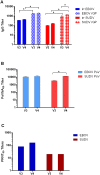Human Polyclonal Antibodies Produced through DNA Vaccination of Transchromosomal Cattle Provide Mice with Post-Exposure Protection against Lethal Zaire and Sudan Ebolaviruses
- PMID: 26422247
- PMCID: PMC4589376
- DOI: 10.1371/journal.pone.0137786
Human Polyclonal Antibodies Produced through DNA Vaccination of Transchromosomal Cattle Provide Mice with Post-Exposure Protection against Lethal Zaire and Sudan Ebolaviruses
Abstract
DNA vaccination of transchromosomal bovines (TcBs) with DNA vaccines expressing the codon-optimized (co) glycoprotein (GP) genes of Ebola virus (EBOV) and Sudan virus (SUDV) produce fully human polyclonal antibodies (pAbs) that recognize both viruses and demonstrate robust neutralizing activity. Each TcB was vaccinated by intramuscular electroporation (IM-EP) a total of four times and at each administration received 10 mg of the EBOV-GPco DNA vaccine and 10 mg of the SUDV-GPco DNA vaccine at two sites on the left and right sides, respectively. After two vaccinations, robust antibody responses (titers > 1000) were detected by ELISA against whole irradiated EBOV or SUDV and recombinant EBOV-GP or SUDV-GP (rGP) antigens, with higher titers observed for the rGP antigens. Strong, virus neutralizing antibody responses (titers >1000) were detected after three vaccinations when measured by vesicular stomatitis virus-based pseudovirion neutralization assay (PsVNA). Maximal neutralizing antibody responses were identified by traditional plaque reduction neutralization tests (PRNT) after four vaccinations. Neutralizing activity of human immunoglobulins (IgG) purified from TcB plasma collected after three vaccinations and injected intraperitoneally (IP) into mice at a 100 mg/kg dose was detected in the serum by PsVNA up to 14 days after administration. Passive transfer by IP injection of the purified IgG (100 mg/kg) to groups of BALB/c mice one day after IP challenge with mouse adapted (ma) EBOV resulted in 80% protection while all mice treated with non-specific pAbs succumbed. Similarly, interferon receptor 1 knockout (IFNAR(-/-)) mice receiving the purified IgG (100 mg/kg) by IP injection one day after IP challenge with wild type SUDV resulted in 89% survival. These results are the first to demonstrate that filovirus GP DNA vaccines administered to TcBs by IM-EP can elicit neutralizing antibodies that provide post-exposure protection. Additionally, these data describe production of fully human IgG in a large animal system, a system which is capable of producing large quantities of a clinical grade therapeutic product.
Conflict of interest statement
Figures






References
-
- Feldmann H, Jones S, Klenk HD, Schnittler HJ. Ebola virus: from discovery to vaccine. Nature reviews Immunology. 2003;3(8):677–85. - PubMed
-
- Feldmann H, Klenk HD. Filoviruses In: Baron S, editor. Medical Microbiology. 4th ed Galveston (TX) 1996. - PubMed
-
- Feldmann H, Slenczka W, Klenk HD. Emerging and reemerging of filoviruses. Archives of virology Supplementum. 1996;11:77–100. - PubMed
-
- Kuhn JH. Filoviruses. A compendium of 40 years of epidemiological, clinical, and laboratory studies. Archives of virology Supplementum. 2008;20:13–360. - PubMed
Publication types
MeSH terms
Substances
LinkOut - more resources
Full Text Sources
Other Literature Sources
Medical
Molecular Biology Databases

